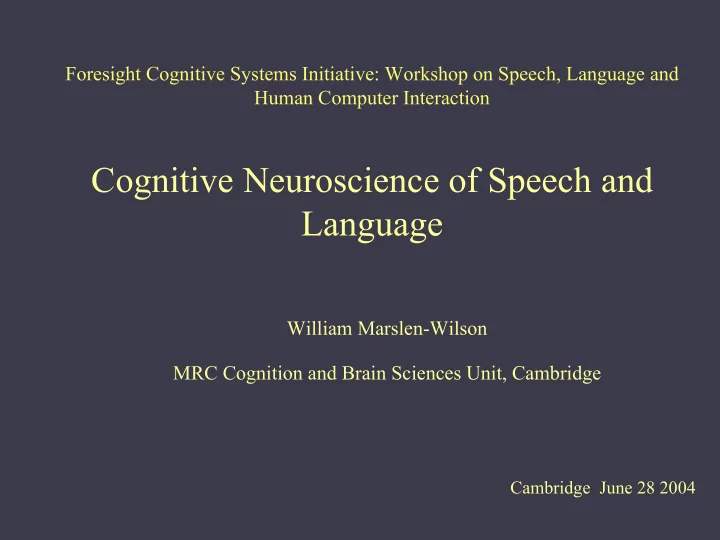

Foresight Cognitive Systems Initiative: Workshop on Speech, Language and Human Computer Interaction Cognitive Neuroscience of Speech and Language William Marslen-Wilson MRC Cognition and Brain Sciences Unit, Cambridge Cambridge June 28 2004
• Global Foresight challenge - science funding on a 10-20 year horizon • Specific Foresight challenge - exploit potential synergies in the interaction between computer scientists/engineers and neuroscientists/cognitive scientists in the development of complex cognitive systems
• Cognitive/psycholinguistic accounts of the functional structure of the language system. • Neuropsychological tradition of cortical localisation of language function • Neurobiology of relevant brain systems; primate neuroanatomy and neurophysiology • Speech and language processing in the human brain • Cross-language/modality comparisons
Ascending auditory system Auditory cortex Many stages Temporal lobe Information highly processed by Superior colliculus the time it reaches cortex Medial geniculate body Brainstem processes are sensitive to speech information Commissure of the Brachium of the inferior colliculus inferior colliculus BUT: Inferior colliculus Nucleus of the lateral lemniscus Medial lemniscus Speech-specific processing (probably) unique to cortex. Lateral lemniscus Cochlear nuclei Superior olivary nucleus Cochlea Trapezoid body
Neurological tradition of cortical localisation of language function: Left peri-sylvian language system
Cognitive models in the brain Indefrey & Levelt, Cognition 2004
Friederici, TICS 2002
Implications of neurobiological models: close linkage between neuroanatomical organization and functional organization • Multiple parallel processing streams • Hierarchical - locally and globally? • Complex in space and time
Neurobiology of relevant brain systems: primate neuroanatomy and neurophysiology (Rauschecker & Tian, PNAS , 2000)
• Arguably provides model of neural and functional specificity achievable for human system • Explanation in terms of multiple hierarchical pathways But • Macaque brain not identical to human brain • Primate auditory processing not the same as spoken linguistic communication (though see Poremba et al, Science 2004) (Many thanks to Ingrid Johnsrude for use of some of the following slides)
Auditory cortex in macaque monkey composed of : Core Belt Parabelt concentrically arranged Belt Belt Kaas JH & Hackett TA (1998) Audiol Neurootol, 3:73-85 Kaas JH & Hackett TA (1998) Audiol Neurootol, 3:73-85
Homologues in human brain
Hierarchical organisation of processes in human primary auditory cortex (belt, parabelt) Left Hemisphere Right Hemisphere noise-silence fixed-noise pitch change-fixed (from Patterson, Uppenkamp, Johnsrude & Griffiths, Neuron , 2002)
Possible processing streams: Belt and parabelt connections with prefrontal cortex in the macaque CL CPB ML AL RPB Adapted from Romanski LM, Tian B et al (1999) Nature Neurosci, 2:1131-1136
Petrides M & Pandya, DN (1988). J Comparative Neurology, 273, 52-66
Parietal: Pandya & Seltzer (1982) J Comp Neurol, 204: 196-210 STS: Seltzer & Pandya (1991) J Comp Neurol 312: 625-40.
Functional evidence for hierarchical organization of processing streams Scott & Wise, Brain 2000
Hierarchical organization of processing streams Activation as a function of intelligibility for auditorily presented sentences (Davis & Johnsrude, J. Neurosci , 2003). Colour scale plots intelligibility- responsive regions which showed a reliable difference between different forms of distortion (orange to red) or no reliable difference between distortions (green to blue).
Bilateral hierarchy emerging from meta- analyses of neuro- imaging research on speech and language processing Indefrey & Cutler, 2003
Electrocortical localisation using cortical stimulation (functional lesions) Boatman, Cognition 2004
Transmission latencies: closely interconnected perisylvian networks 10 ms MFG s m 6 2 ms IFG PLST 10 ms ITG MTG Brugge et al (2003) J Neurophysiol., 90 3750-63. Greenlee et al (in press) J Neurophysiol.
Dynamic spatio- temporal activation patterns in MEG Marinkovic et al Neuron 2003
Core peri-sylvian language system • Multiple processing streams • Locally (globally?) hierarchical • Bilateral • Complex in space and time
Challenges • Multi-modal imaging: capturing spatio-temporal dynamics • In vivo neuroanatomy (tractography) • Neuro-biologically realistic computational modelling • Learning and plasticity And many others….
Recommend
More recommend